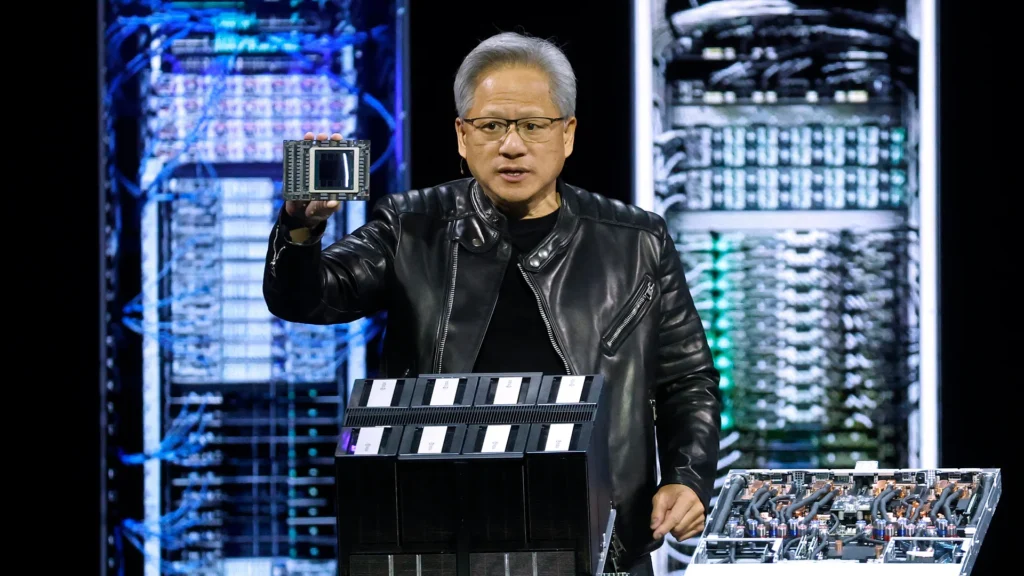Artificial Intelligence (AI) is at a turning point, and we’re diving into what this means with insights from Nvidia’s Jensen Huang. Recently, at the GTC 2025 conference, hailed as “AI Woodstock,” Huang delivered captivating news about Nvidia’s innovative advancements in AI technology.
From revealing next-gen chip architectures to discussing the massive potential of AI, Huang’s address was nothing short of transformative. Nvidia’s plans might reshape computing’s future as we know it. Let’s explore how AI is evolving with each technological leap and its implications on industries and everyday life.
The Dawn of Next-Gen Chips
Nvidia is pushing boundaries with its next-gen graphics architectures—Blackwell Ultra and Vera Rubin. The Blackwell Ultra is expected to make its debut in late 2025, followed by the Rubin AI chip in 2026. These innovations promise to enhance computing capabilities significantly.
Huang emphasized the monumental shift these chips will bring. Named after the famous astronomer Vera Rubin, these powerful chips are set to revolutionize computational power, supporting advanced AI functions. Tech enthusiasts are buzzing about the potential developments.
These chips mark a leap in AI technology, enabling faster processing and more complex AI tasks. As Nvidia continues to innovate, the tech world is abuzz with excitement about these new possibilities.
AI: From Vision to Reasoning
The shift from simple perception to reasoning represents a fundamental change. This change enhances AI’s utility in real-world applications. As AI understands context better, the quality and relevance of its outputs improve.
This leap forward in AI capabilities is paving the way for more intuitive and responsive technology. It’s an exciting time to be part of the AI revolution, as these advancements unlock new levels of potential.
The Surging Demand for GPUs
The demand for Graphics Processing Units (GPUs) is surging, especially from top cloud service providers. These companies are ramping up GPU usage to support sophisticated AI tasks.
According to Huang, the demand growth is unstoppable. Nvidia is expected to see its data center infrastructure revenue skyrocket to $1 trillion by 2028.
Cloud providers are embracing Nvidia’s technology to enhance their AI capabilities further. This embrace promises a more robust and efficient cloud computing environment, benefiting users across the globe.
AI in the Automotive Industry
Nvidia’s impact reaches beyond traditional tech. It’s paving new roads in the automotive industry, especially in autonomous driving.
With the integration of Nvidia’s tech, companies like General Motors are advancing their self-driving fleets. This integration marks a significant step in autonomous vehicle technology.
Nvidia’s Halos system is a standout, emphasizing autonomous driving safety. As the first AI safety solution with code fully assessed for safety, it sets the industry standard.
Extraordinary Progress in AI
AI’s progress over the past decade is remarkable. It has transitioned from exploring perception in its infancy to honing reasoning capabilities. This progress is a testament to the innovation driving the tech industry.
Huang’s remarks at GTC 2025 emphasized the extraordinary advancements. As AI continues to evolve, its applications expand across various domains, from healthcare to entertainment.
The strides made in AI are unlocking new possibilities and enhancing the way we interact with technology. The future is promising for continuously evolving AI tech.
Autonomous Driving: The Next Frontier
Autonomous driving technologies are rapidly advancing. Huang’s presentation at the conference highlighted Nvidia’s key role in this domain.
The development of self-driving cars relies heavily on sophisticated AI systems. Nvidia’s chips are at the forefront, steering this innovation. Their integration into vehicles ensures enhanced safety and efficiency.
Safety and reliability are the hallmarks of Nvidia’s autonomous tech. By setting high standards, they are fostering trust in autonomous systems among consumers. This trust is crucial for the widespread adoption of these technologies.
The Role of AI in Computing
AI is fundamentally changing computing paradigms. As Huang noted, AI understands context and task meaning, altering computing dynamics.
The transformative nature of AI is reshaping traditional computing approaches. Companies leveraging AI effectively reap significant benefits. This reshaping offers opportunities for innovation and operational improvement.
AI’s role in computing is increasingly prominent. It drives efficiency and innovation, opening doors to new technological advancements.
The enhancements in AI offer a glimpse into what the future of computing holds. As we move forward, AI’s integration into various sectors promises groundbreaking developments.
Nvidia’s Future Vision
Nvidia is gearing up for a transformative era, driven by AI advancements. Huang’s forward-thinking vision highlights the potential of future technologies.
Anticipating drastic changes in industry dynamics, Nvidia plans to stay at the forefront of innovation. This anticipation includes new product launches and technology enhancements.
By continuing its innovation journey, Nvidia aims to lead the future of AI technology. Such leadership is expected to shape industry standards.
The Unstoppable Force of AI
AI’s momentum shows no signs of slowing. As technology evolves, industries must adapt to harness AI effectively.
Huang’s insights shed light on the future trajectory of AI, underscoring its potential to revolutionize numerous fields.
The ongoing advancements in AI promise to reshape the way we interact with technology and the world. The future of AI is an exciting space to watch, with countless possibilities emerging.
As AI stands at the forefront of a new era, Nvidia’s innovations underline the endless possibilities ahead. This technology is poised to redefine industries and everyday life, marking a pivotal moment in tech history.





